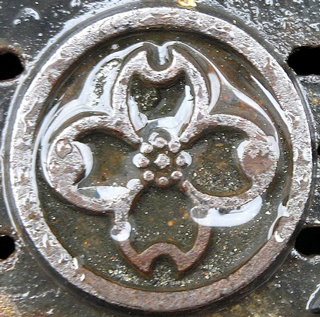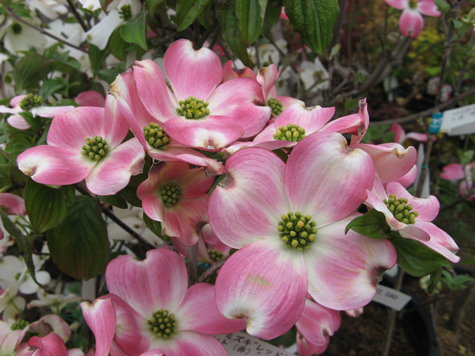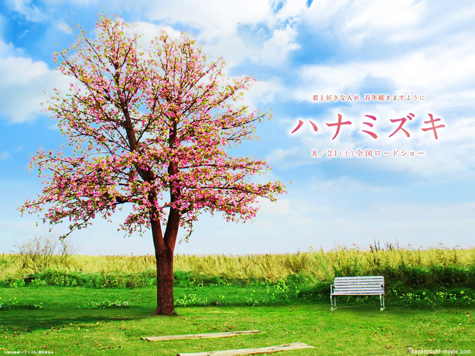Human Flower Project
Japan ~ U.S.A.: Dogwood Solidarity
Masashi Yamaguchi returns to report on how the dogwood tree has brought Transpacific gratitude and sympathy. Thank you, Masashi!

Dogwood blossom manhole cover, Minato-ku, Tokyo
Photo: nofrills
By Masashi Yamaguchi
Several years ago, in an article on Japanese cherry blossom trees for Human Flower Project. I wrote that the Japanese government had utilized these trees for promoting international friendship. In 1912, the governor of Tokyo sent 3,000 cherry blossom trees to Washington, D.C., as a token of friendship between Japan and the United States.
Actually the story continued: then-president Howard Taft and his wife Helen sent 50 dogwood trees in return three years later. They were planted as roadside trees and spread all over Japan.
I have heard that dogwood is the state flower of Virginia. It blooms in early May and its flower has four petals (exactly, they are not petals but leaves for decorating real small green flowers). Its habitat is humid places so it needs more water to grow compared with other trees; thus it is called “HANAMIZUKI” (= flowering water tree) in Japanese.

Hanamizuki (Cornus florida)
Photo: Masashi Yamaguchi
The Japanese have appreciated this flower for about a hundred years and I understand that its simple flower shape with white or pale pink color really suits the Japanese esthetic taste. I would like to share with you the recent episode on “dogwood” in Japan.
I still remember the moment when I first saw the scene of the collapse of the World Trade Center buildings by the attack of an airplane. I was watching the live TV broadcast of New York City on the 911 terrorism but I could not believe that this really happened; it was like a disaster scene of a movie. However it happened. (It really happened, like the 311 earthquake disaster in Japan. Disaster is a disaster whether caused by human beings or by the mother earth.)
At that time, a Japanese singer songwriter Yo Hitoto received e-mail from her friend living in New York. Shocked and deeply depressed, she wrote a poem on 911 as a way to relieve her feelings. She wrote over and over to calm down and then completed the lines:
To the sky you reach out your hand.
The songs of the clouds call you to distant lands.
To the wind you call my name, carried to the shore, the shore where I wait.
A dogwood flower, I’d give to you.
A blossom, then, soon come to you.
May the dreams you hold, the dreams that shine like rose and gold last forever.
I wish for you to shine above to radiate your endless love.
May it last a hundred years from now.
Summer heat weighing down on us.
This boat is too weak and so in me, please trust.
I will follow you. Please go ahead and I will be there soon.
*translated by Suzi Kim and Hayley Westenra.
What do you think of these lines? For me, the poem seems a prayer for the living people from the dead victims of 911. Yo Hitoto composed these lines and introduced the song “HANAMIZUKI” (= dogwood flower) in 2003. This song became a big hit for more than five years after the release and is often sung in karaoke.
This song has been covered by many singers both in Japan and in other countries. Hayley Westenra, a singer in New Zealand, is one singer who performs this song. She translated the lyrics as above and covered it. I am very drawn to her beautiful voice.

Poster for the Japanese movie Hanamizuki, (2000)
Image: 14th Japanese Film Festival
The popularity of this song finally created the movie named “HANAMIZUKI,” released last year (2010). The director was inspired by the lyrics and developed a scenario. I think that the story (lovers who separated to chase their own dreams meet again under a dogwood tree after 10 years) was not so good but the power of the song made this movie a big hit. Here is a link to another version of “HANAMIZUKI” sung by the main actress of the movie, Yui Aragaki.

Sojiro Ito, speaker of Japan’s upper house of parliament, and Ohio Gov. Bob Taft planted a dogwood tree in Tokyo, February 2000.
Photo: AP
Also carrying the dogwood story on, in February 2000 Ohio Governor Bob Taft, great-grandson of the former president, brought 50 more dogwoods to Japan. Gov. Taft presented the Ohio-grown dogwoods during a trade mission to Japan.
“The Japanese put tremendous emphasis on recognizing history and tradition, and if they can, continuing it,” said Christopher LaFleur, a minister from the U.S. Embassy in Tokyo.
“Gov. Taft, by coming to Japan and being here, carries forward a tradition of friendship and exchange that was begun by his relatives. It was very special for them. They appreciate that.”
I think that the Japanese do not directly express their real feelings such as happiness, anger and sadness. However, I also think that they offer hints of such feelings to others by using flower names, tree names and references to other things in nature. This may be because Japan has basically been kept in peace compared with other countries. I wonder if the Japanese people have tended to express themselves indirectly – through cherry blossoms and dogwoods—to refrain from conflict.


Masashi, thank you very much. More cherries and dogwoods, please!